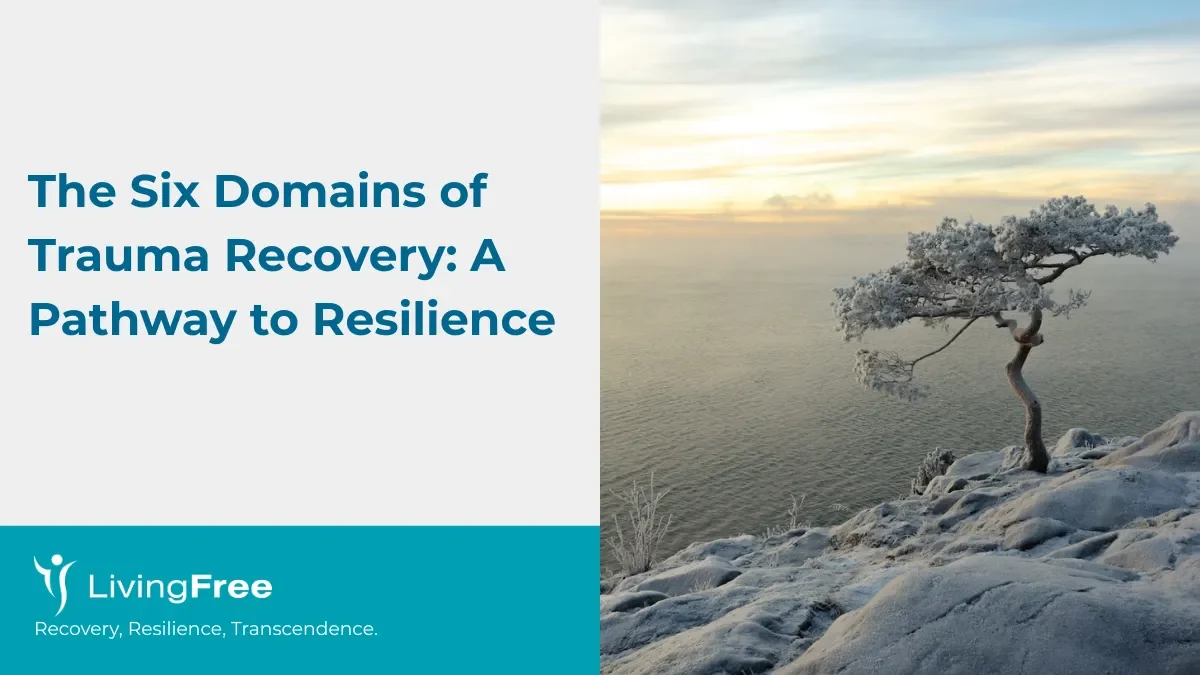Recovery from trauma is not about erasing the past or avoiding triggers. It is about building resilience across every area of life that trauma touches. At Living Free, we use a six-domain model of trauma recovery, developed through clinical practice and neuroscience, to guide individuals toward healing and long-term growth.
This model recognizes that trauma affects more than thoughts and emotions. It impacts the body, relationships, behaviors, and even the meaning we attach to life. By working through each domain, recovery becomes a structured, holistic process.
1. Cognition and Beliefs
Trauma often leaves behind distorted beliefs such as “I am not safe,” “It was my fault,” or “I am unworthy.” These beliefs become “stuck points” that shape how we see ourselves and the world.
Healing in this domain means:
- Identifying and challenging negative cognitions.
- Reframing trauma-related thoughts with balanced perspectives.
- Rebuilding self-trust and confidence.
Therapies used: CBT, CPT, EMDR.
2. Emotional Regulation
After trauma, emotions can feel unpredictable and overwhelming. Survivors may experience sudden anger, fear, shame, or numbness. The nervous system can swing between hyperarousal (high anxiety, panic) and hypoarousal (shutdown, dissociation).
Healing in this domain means:
- Learning to notice and name emotions safely.
- Using grounding and mindfulness practices to stay present.
- Building tolerance for distress without becoming overwhelmed.
Therapies used: Somatic Coaching, Breathwork, DBT-informed techniques.
3. Somatic and Nervous System Stability
Trauma is stored in the body. Symptoms like chronic pain, fatigue, digestive problems, or sleep disruption are common. The autonomic nervous system often remains “on alert” long after the danger has passed.
Healing in this domain means:
- Reconnecting with the body through safe movement and awareness.
- Using breathwork and somatic practices to regulate the nervous system.
- Restoring balance in sleep, nutrition, and exercise.
Therapies used: Somatic Coaching, EMDR, Psychoeducation, Lifestyle Coaching.
4. Relationships and Connection
Trauma damages trust. Survivors may fear closeness, struggle with boundaries, or feel unsafe relying on others. This leads to cycles of isolation or unhealthy attachments.
Healing in this domain means:
- Rebuilding trust in safe relationships.
- Developing healthy boundaries and communication.
- Repairing attachment wounds and restoring connection.
Therapies used: IFS (Parts Work), Individual Psychotherapy, Couples Therapy.
5. Behavior and Coping Patterns
Many survivors develop maladaptive coping strategies to manage pain, such as substance use, eating disorders, or compulsive behaviors. While these strategies may bring short-term relief, they often reinforce distress in the long term.
Healing in this domain means:
- Identifying harmful behaviors and their triggers.
- Replacing them with healthier coping strategies.
- Building consistent habits that support stability.
Therapies used: Behavioural Psychology, Behavioural Coaching, IOP programs.
6. Meaning and Purpose
Perhaps the deepest wound of trauma is the way it strips meaning from life. Survivors may feel hopeless, powerless, or disconnected from purpose. Healing requires more than reducing symptoms — it means rediscovering identity, values, and direction.
Healing in this domain means:
- Exploring questions of meaning, purpose, and identity.
- Reclaiming agency in life choices.
- Developing goals that support growth and fulfilment.
Therapies used: Individual Psychotherapy, Executive & Career Coaching, Spiritual or values-based exploration.
Living Free’s Integrated Approach
The six domains of trauma recovery are not treated in isolation. At Living Free, we integrate them into every therapy plan. For example, EMDR may target intrusive memories (cognition), while breathwork helps regulate arousal (nervous system), and coaching builds healthier habits (behavior).
By addressing all six domains together, recovery becomes holistic. Clients not only reduce symptoms but also gain resilience, rebuild relationships, and rediscover meaning in life.
Related Articles
The “Shit Happens” Model: Building Real Trauma Resilience
Trauma Triggers in Relationships
Why Avoiding Triggers Does Not Heal Trauma
Can You Have PTSD Without Knowing It?
Conclusion
Trauma recovery is not about forgetting what happened. It is about learning to live fully again. The six-domain model offers a roadmap that makes healing structured and possible. With the right support, survivors can move beyond survival and into resilience, connection, and growth.
If you are ready to begin your journey, contact us to connect with a Living Free psychotherapist.


